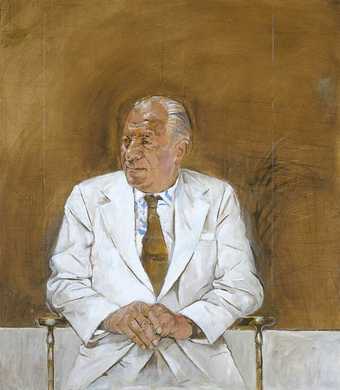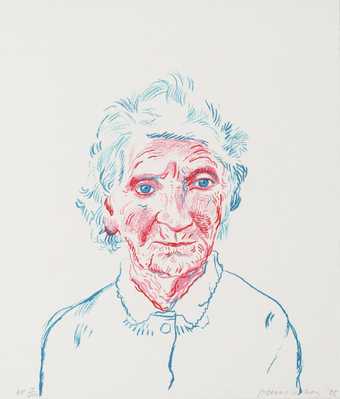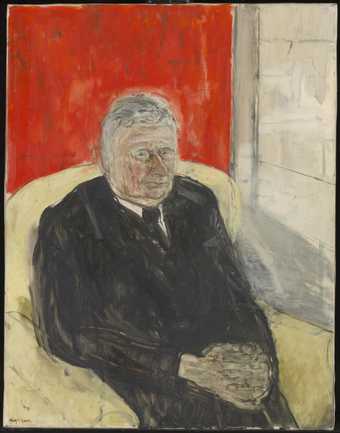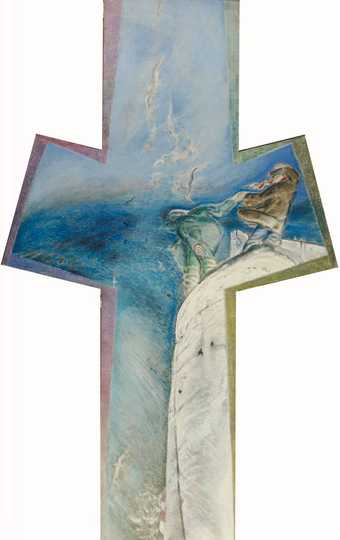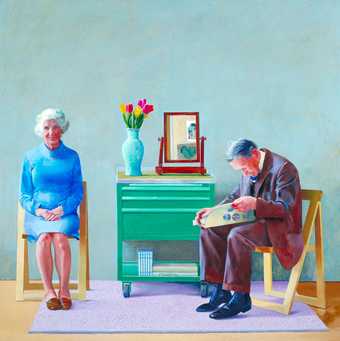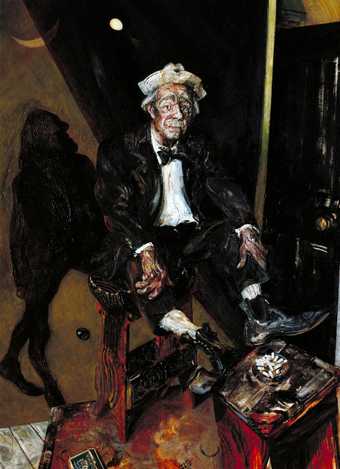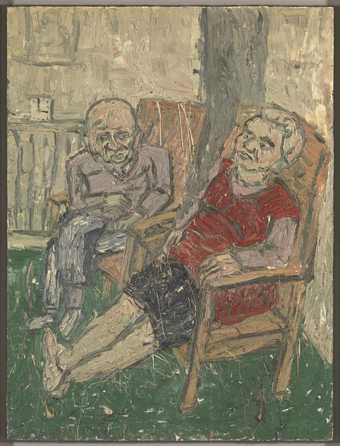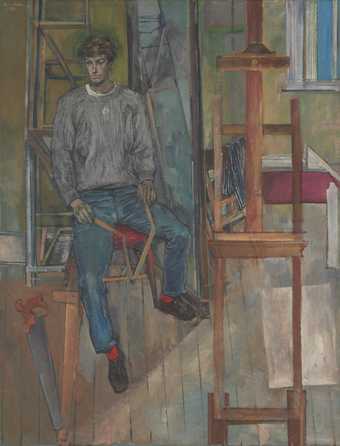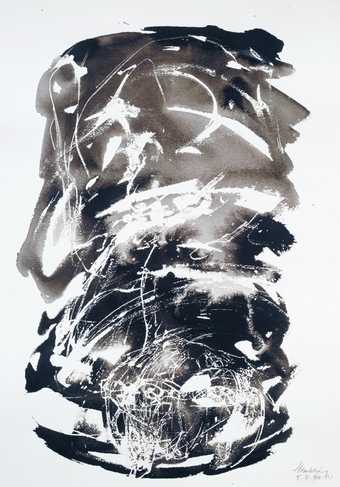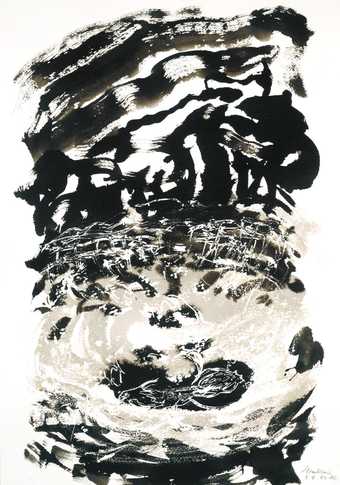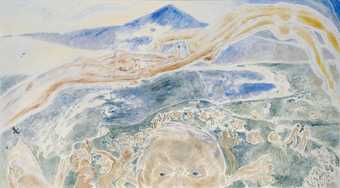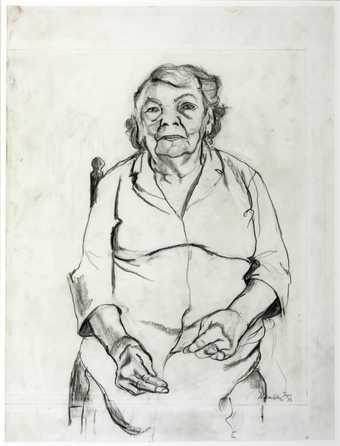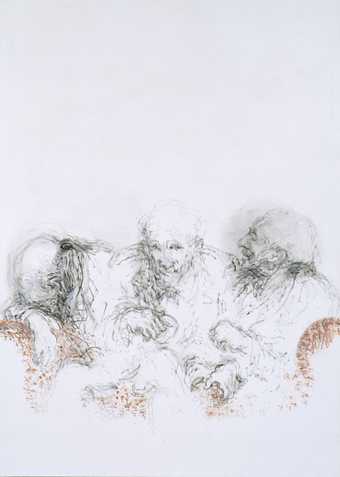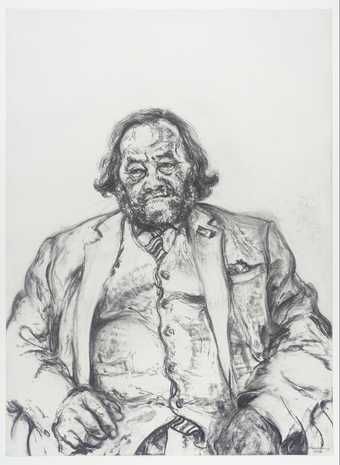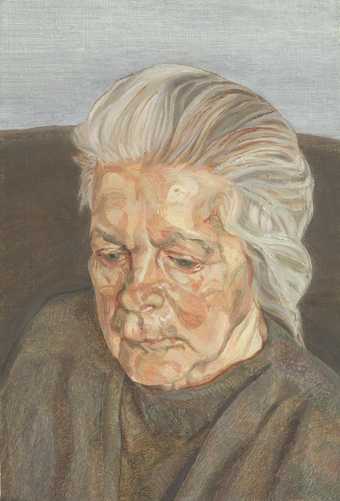
Not on display
- Artist
- Maggi Hambling born 1945
- Medium
- Oil paint on canvas
- Dimensions
- Support: 1083 × 1012 mm
- Collection
- Tate
- Acquisition
- Presented by the Friends of the Tate Gallery 1994
- Reference
- T06786
Summary
Portrait of Frances Rose marked Maggi Hambling's return to painting after a four year period of performance and installation art. Following the practice taught to her by Cedric Morris and Arthur Lett-Haines at their private art school in Benton End, Suffolk, Hambling made preliminary drawings from life for the painting. She then worked from these drawings exclusively when painting the picture.
Frances Rose, the subject of four portraits by Hambling between 1973 and 1975, was the artist's neighbour in Clapham, London. From a working class background, she was a widow in her early eighties when the picture was painted. According to Hambling, Mrs Rose commonly wore the blue dress and always had a clip in her hair. Her twisted arthritic hands were, in Hambling's view, a result of a life spent in domestic service. The ring on her left hand is her wedding ring.
The over life-size figure is presented sitting off-centre and frontal against a white wall in the artist's studio. Hambling is unflinching in her appraisal of the sitter's appearance; the facial warts, sagging leathery skin and gnarled hands are testimony to an approach based on intense unsentimental observation of the individual. The face is built-up with a thick impasto, giving its weathered features a three-dimensional presence. The sitter's eyelids, nostrils and the folds of her jowls all stand proud of the rest of the picture surface; the eyes themselves are recessed in the mass of paint. In contrast, the blue dress and the green chair seat have been worked up using thin washes of paint. The juxtaposition of these textural effects and the picture's vivid chromatic contrasts contribute to the immediacy of the image.
Hambling's close scrutiny of her portrait subjects has often been compared to the work of Lucian Freud, another former student at Benton End. However, critics have tended to note a greater degree of compassion in her work compared to the alleged severity of Freud's. Hambling herself has acknowledged an interest in many artists including Rembrandt and Francis Bacon, but above all she cites the visionary painter, sculptor and writer Lett-Haines as her mentor.
Further reading:
Maggi Hambling: Paintings, drawings and watercolours, Serpentine Gallery, London 1987
Max Wall Pictures by Maggi Hambling, National Portrait Gallery, London 1983
Toby Treves
April 2000
Does this text contain inaccurate information or language that you feel we should improve or change? We would like to hear from you.
Display caption
From the age of fifteen Hambling studied with the painters Cedric Morris and Arthur Lett Haines at their private art school, Benton End, in Suffolk. Her first London exhibition in 1973 included portraits of people observed in pubs and painted from memory. This portrait is an extremely significant work in Hambling's oeuvre as it marks the beginning of her return to drawing and painting from life, a discipline she was taught at Benton End. Frances Rose was a widow in her early eighties who was Hambling's next-door neighbour in Battersea, and who greatly enjoyed sitting for her portrait.
Gallery label, September 2004
Does this text contain inaccurate information or language that you feel we should improve or change? We would like to hear from you.
Technique and condition
The following entry is based on an interview with the artist held on 5 April, 1995.
Painted in oil paint on a cotton canvas over a period of approximately 4 weeks. The artist constructed the strainer herself onto which she stretched a medium weight cotton duck canvas supplied by Russell & Chapple. The canvas was prepared with two coats of rabbit-skin glue size.
The painting was made directly from the pencil drawing, Study for Portrait of Frances Rose for which the sitter posed, On acquisition the strainer was replaced, with the consent of the artist, and the canvas was restretched onto a wooden stretcher. The painting was surface cleaned and minor scratches in the figure's dress reduced. It is framed in a simple moulded painted frame, approved by the artist. Jo Crookthe drawing was made from life and this painting painted from the drawing.
The artist did not apply a preparatory drawing to the canvas. The paint is a combination of Winsor & Newton and Spectrum artists' oil colours, thinned with white spirit. The image has been built up in many layers of paint worked wet-into-wet, using a painting knife and her fingers as well as brushes to physically sculpt the figure in paint. The eyelids were drawn into the wet paint with the other end of the paint brush; as the artist later remarked,
like carving the paint.
July 1997
Explore
- people(22,072)
-
- adults(20,120)
-
- woman, old(265)
- diseases and conditions(1,487)
-
- arthritis(1)
- named individuals(12,887)
- portraits(4,491)
-
- individuals: female(1,698)
You might like
-
Graham Sutherland OM Portrait of Sir Charles Clore
1965–75 -
David Hockney Portrait of Mother III
1985 -
Olwyn Bowey Portrait Sketch of L.S. Lowry
1963–64 -
Jeffery Camp Beachy Head: Brink
1975 -
David Hockney My Parents
1977 -
Maggi Hambling Max Wall and his Image
1981 -
Leon Kossoff Two Seated Figures No. 2
1980 -
John Minton Portrait of Kevin Maybury
1956 -
Maggi Hambling Mud Dream 1
1990 -
Maggi Hambling Mud Dream 6
1990 -
Jeffery Camp Southcoast
1990 -
Maggi Hambling Study for Portrait of Frances Rose
1973 -
Maggi Hambling Father, Late December 1997
1997 -
Maggi Hambling Portrait of Dr David Brown
1986 -
Lucian Freud The Painter’s Mother IV
1973

